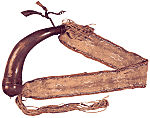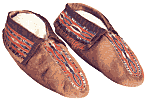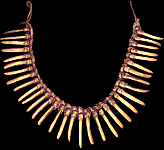FIRST NATIONS of the PLAINS -
CLOTHING
PREPARING THE HIDE
-The hide was scraped to remove the fat and hair.
-Sometimes the hair was left on the outside for warmth.
-The hide was stretched flat on the ground or laced to a frame.
-The hide was rubbed with a mixture of liver and brains
-Then the skin was soaked to soften it.
-It was rubbed with a smooth stone till it was soft.
-Hides were sewn together using an awl and bone needles.
-Sinew (muscles) was used for thread.
MEN'S AND WOMEN'S CLOTHING
|
The men wore long shirts , breechcloths, long leggings, a belt and moccasins.
The women wore long dresses , short leggings (knee-high) and moccasins.
The leggings were made of buckskin, were wider at the top and narrower at the ankles, and laced up along the sides with leather ties. Some leggings were decorated with beadwork. Leggings protected the legs and kept the legs warm. The dresses were made of hide that draped over the shoulders. The sides were sewn together with sinew or leather strips. Ponchos were worn over the shoulders for warmth. In cold weather the men put on robes and high boots made from buffalo hides. | 
(man's shirt & woman's dress) |
BELTS, POUCHES, BAGS, MOCCASINS
|
Belts were made from strips of hide. Both the men and women wore belts.
Small pouches and knives were often hung from the belts.
The shoes were called moccasins. Different styles of moccasins were worn by the various tribes. Most moccasins were made of moose hide or buffalo hide.
| 
 |
PARFLECHE

A parfleche was a type of bag made from the hide of a bison.
Hide was prepared by soaking, cleaning, dehairing, then stretching the skin and drying it in the sun. Parfleches were used to carry dried food, medicine, personal items and tools. A single piece of rawhide was folded into a case and tied shut with rawhide laces. Parfleches were also box-shaped or tube-shaped or made into pouches. The outside of a parfleche was decorated. A large parfleche was used as a saddlebag.
LEATHER BAGS

Clothing and other items were kept in drawstring bags of tanned hide. Some bags had flaps at the top. The bags were decorated with quills and beads or had designs painted on.
HIDE PAINTINGS
War deeds and other events were painted on animal skins and kept as a record of important things that happened.
DECORATION
Bags, belts and special clothing for ceremonies were decorated with shells, claws, feathers, quillwork, hair or strips of fur. Later colorful beads were used. Tails of animals (weasel and fox) were also used for decoration. Clothing that was worn daily was not decorated, except for a row of beadwork or fringes.

Jewelry was made from shells, claws, teeth or feathers.

